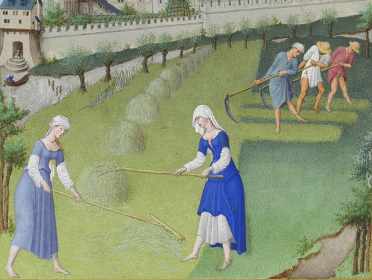Feudal Society in the Middle Ages

Table of Contents
- Emergence of Serfdom
- The System of Vassalage
- Structure of the Feudal Society
- Rise of Power of the Royal Officials and Great Landlords
- Decline and Abolition of the Feudalism
Emergence of Serfdom
Early medieval Europe was marked by severe economic crisis, collapse of urban centers, weakening of central power and major insecurity due to invasions of nomadic peoples and rivalry between the newly formed barbarian kingdoms. This resulted in the growing need for protection which could had been provided only by a highly trained military force. Powerful landlords began to surround themselves with private warriors, while peasants and small landholders could “buy” protection at the nearest landlord by accepting to become serfs. They transferred their land to their protector and received it back as precarium, a tenure burdened by certain fees and taxes (usually in the form of agricultural goods). They were typically also required to provide labor and promise never to leave their tenure.
The System of Vassalage
The landlords, on the other hand, sought protection at more powerful landlords. They too were forced to surrender their land to their protector. They received it back as a fief by which they became their overlord’s vassals. In contrary to peasants, they were required pledge fealty, pay homage and provide military service to their protector. Fiefs, however, could also be granted in return for submission and allegiance. Unlike serfs who also accepted serfdom in the name of their descendants, vassals did not bind their descendants. But if their successors wanted to inherit the fief, they had to pay homage, pledge fealty and provide military service to their overlord otherwise the lord could deprive them of their fief.
Structure of the Feudal Society
On the top of an ideal feudal society in the Middle Ages was the king who owned all the land. Below the king was nobility that held fiefs directly from the king in return for their allegiance and military service. Land could also be bestowed to clergy in return for spiritual services and political support. Peasants who were on the bottom of the feudal society held land from their lord in return for dues and providing labor. But feudal society in the Middle Ages was much more complex. In addition, a part of the medieval population was excluded from the feudal social organization – city population, Jews, disabled people, foreigners and some other social groups that were different from the majority of population in way or the other.
Rise of Power of the Royal Officials and Great Landlords
In order to facilitate control over their kingdoms, the kings divided their territory into administrative units - duchies or counties and appointed one of their vassals to govern the territory in their behalf. In return for their administrative, legislative and fiscal services (they also judged in king’s behalf and collected taxes), dukes and counts were awarded with benefices in the form of land. Since dukes and counts typically originated from high nobility holding their own properties, further benefices and increased need for local protection enabled them to dramatically extend their wealth and influence. Many eventually became overlords to literally all free men (and other king’s vassals) within their administrative units as the vassalage system allowed the so-called subinfeudation according to which a vassal could grant a part of his fief to another man who then became his vassal. As a result, many duchies and counties evolved into little kingdoms within a larger one.
Decline and Abolition of the Feudalism
The rise of powerful monarchs who strengthened the central authority, increase in communications, replacement of knights with the regular army and sociocultural changes - in the first place the rise of the cities and bourgeoisie at the end of the Middle Ages led to gradual decline of the feudal system. However, it survived in much of Europe until the 19th century. In France, feudalism was abolished only after the French Revolution of 1789, while serfdom in the Habsburg Monarchy survived until 1848 and in Russia until 1861.




